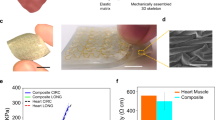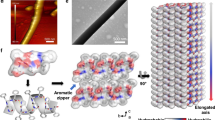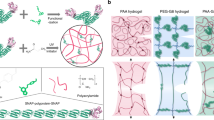Abstract
Naturally occurring elastomeric proteins function as molecular springs in their biological settings and show mechanical properties that underlie the elasticity of natural adhesives1, cell adhesion proteins2 and muscle proteins3. Constantly subject to repeated stretching–relaxation cycles, many elastomeric proteins demonstrate remarkable consistency and reliability in their mechanical performance3,4. Such properties had hitherto been observed only in naturally evolved elastomeric proteins. Here we use single-molecule atomic force microscopy techniques to demonstrate that an artificial polyprotein made of tandem repeats of non-mechanical protein GB1 has mechanical properties that are comparable or superior to those of known elastomeric proteins. In addition to its mechanical stability5, we show that GB1 polyprotein shows a unique combination of mechanical features, including the fastest folding kinetics measured so far for a tethered protein, high folding fidelity, low mechanical fatigue during repeated stretching–relaxation cycles and ability to fold against residual forces. These fine features make GB1 polyprotein an ideal artificial protein-based molecular spring that could function in a challenging working environment requiring repeated stretching–relaxation. This study represents a key step towards engineering artificial molecular springs with tailored nanomechanical properties for bottom-up construction of new devices and materials6.
This is a preview of subscription content, access via your institution
Access options
Subscribe to this journal
Receive 12 print issues and online access
$259.00 per year
only $21.58 per issue
Buy this article
- Purchase on Springer Link
- Instant access to full article PDF
Prices may be subject to local taxes which are calculated during checkout




Similar content being viewed by others
References
Smith, B. L. et al. Molecular mechanistic origin of the toughness of natural adhesives, fibres and composites. Nature 399, 761–763 (1999).
Oberhauser, A. F., Marszalek, P. E., Erickson, H. P. & Fernandez, J. M. The molecular elasticity of the extracellular matrix protein tenascin. Nature 393, 181–185 (1998).
Labeit, S. & Kolmerer, B. Titins: giant proteins in charge of muscle ultrastructure and elasticity. Science 270, 293–296 (1995).
Bullard, B. et al. The molecular elasticity of the insect flight muscle proteins projectin and kettin. Proc. Natl Acad. Sci. USA 103, 4451–4456 (2006).
Cao, Y., Lam, C., Wang, M. & Li, H. Nonmechanical protein can have significant mechanical stability. Angew. Chem. Int. Edn Engl. 45, 642–645 (2006).
Becker, N. et al. Molecular nanosprings in spider capture-silk threads. Nature Mater. 2, 278–283 (2003).
Tatham, A. S. & Shewry, P. R. Elastomeric proteins: biological roles, structures and mechanisms. Trends Biochem. Sci. 25, 567–571 (2000).
Vogel, V. Mechanotransduction involving multimodular proteins: converting force into biochemical signals. Annu. Rev. Biophys. Biomol. Struct. 35, 459–488 (2006).
Rief, M., Gautel, M., Oesterhelt, F., Fernandez, J. M. & Gaub, H. E. Reversible unfolding of individual titin immunoglobulin domains by AFM. Science 276, 1109–1112 (1997).
Carrion-Vazquez, M. et al. Mechanical design of proteins studied by single-molecule force spectroscopy and protein engineering. Prog. Biophys. Mol. Biol. 74, 63–91 (2000).
Li, H. et al. Reverse engineering of the giant muscle protein titin. Nature 418, 998–1002 (2002).
Kellermayer, M. S., Smith, S. B., Bustamante, C. & Granzier, H. L. Mechanical fatigue in repetitively stretched single molecules of titin. Biophys. J. 80, 852–863 (2001).
Yang, G. et al. Solid-state synthesis and mechanical unfolding of polymers of T4 lysozyme. Proc. Natl Acad. Sci. USA 97, 139–144 (2000).
Brockwell, D. J. et al. Mechanically unfolding the small, topologically simple protein L. Biophys. J. 89, 506–519 (2005).
Best, R. B., Li, B., Steward, A., Daggett, V. & Clarke, J. Can non-mechanical proteins withstand force? Stretching barnase by atomic force microscopy and molecular dynamics simulation. Biophys. J. 81, 2344–2356 (2001).
Cecconi, C., Shank, E. A., Bustamante, C. & Marqusee, S. Direct observation of the three-state folding of a single protein molecule. Science 309, 2057–2060 (2005).
Dietz, H. & Rief, M. Exploring the energy landscape of GFP by single-molecule mechanical experiments. Proc. Natl Acad. Sci. USA 101, 16192–16197 (2004).
Ainavarapu, S. R., Li, L., Badilla, C. L. & Fernandez, J. M. Ligand binding modulates the mechanical stability of dihydrofolate reductase. Biophys. J. 89, 3337–3344 (2005).
Junker, J. P., Hell, K., Schlierf, M., Neupert, W. & Rief, M. Influence of substrate binding on the mechanical stability of mouse dihydrofolate reductase. Biophys. J. 89, L46–L48 (2005).
Gronenborn, A. M. et al. A novel, highly stable fold of the immunoglobulin binding domain of streptococcal protein G. Science 253, 657–661 (1991).
Li, P. C. & Makarov, D. E. Ubiquitin-like protein domains show high resistance to mechanical unfolding similar to that of the 127 domain in titin: Evidence from simulations. J. Phys. Chem. B 108, 745–749 (2004).
Carrion-Vazquez, M. et al. Mechanical and chemical unfolding of a single protein: a comparison. Proc. Natl Acad. Sci. USA 96, 3694–3699 (1999).
Carrion-Vazquez, M. et al. The mechanical stability of ubiquitin is linkage dependent. Nature Struct. Biol. 10, 738–743 (2003).
Chyan, C. L. et al. Reversible mechanical unfolding of single ubiquitin molecules. Biophys. J. 87, 3995–4006 (2004).
Schwaiger, I., Schleicher, M., Noegel, A. A. & Rief, M. The folding pathway of a fast-folding immunoglobulin domain revealed by single-molecule mechanical experiments. EMBO Rep. 6, 46–51 (2005).
Park, S. H., Shastry, M. C. & Roder, H. Folding dynamics of the B1 domain of protein G explored by ultrarapid mixing. Nature Struct. Biol. 6, 943–947 (1999).
Marko, J. F. & Siggia, E. D. Stretching DNA. Macromolecules 28, 8759–8770 (1995).
Kellermayer, M. S., Smith, S. B., Granzier, H. L. & Bustamante, C. Folding–unfolding transitions in single titin molecules characterized with laser tweezers. Science 276, 1112–1116 (1997).
Oberhauser, A. F., Marszalek, P. E., Carrion-Vazquez, M. & Fernandez, J. M. Single protein misfolding events captured by atomic force microscopy. Nature Struct. Biol. 6, 1025–1028 (1999).
Wright, C. F., Teichmann, S. A., Clarke, J. & Dobson, C. M. The importance of sequence diversity in the aggregation and evolution of proteins. Nature 438, 878–881 (2005).
Acknowledgements
This work was supported by the Natural Sciences and Engineering Research Council of Canada, the Canada Research Chairs programme and the start-up fund from the University of British Columbia. Y.C. is partially supported by the Laird Fellowship.
Author information
Authors and Affiliations
Corresponding author
Ethics declarations
Competing interests
The authors declare no competing financial interests.
Supplementary information
Supplementary Information
Supplementary Information; Figures S1 and S2 (PDF 183 kb)
Rights and permissions
About this article
Cite this article
Cao, Y., Li, H. Polyprotein of GB1 is an ideal artificial elastomeric protein. Nature Mater 6, 109–114 (2007). https://doi.org/10.1038/nmat1825
Received:
Accepted:
Published:
Issue Date:
DOI: https://doi.org/10.1038/nmat1825
This article is cited by
-
Cartilage-like protein hydrogels engineered via entanglement
Nature (2023)
-
Templated folding of the RTX domain of the bacterial toxin adenylate cyclase revealed by single molecule force spectroscopy
Nature Communications (2022)
-
Engineering shape memory and morphing protein hydrogels based on protein unfolding and folding
Nature Communications (2022)
-
An ester bond underlies the mechanical strength of a pathogen surface protein
Nature Communications (2021)
-
How to define and study structural proteins as biopolymer materials
Polymer Journal (2020)



